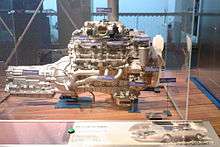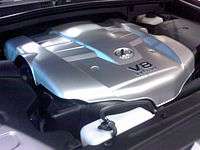Toyota UZ engine
| Toyota UZ Engine | |
|---|---|
|
| |
| Overview | |
| Manufacturer | Toyota Motor Corporation |
| Production | 1989–2013 |
| Layout | |
| Configuration | DOHC 90° V8 |
| Chronology | |
| Predecessor | Toyota V engine |
| Successor | Toyota UR engine |
The Toyota UZ engine family is a Gasoline[1] fueled 32-valve quad-camshaft V8 piston engine series used in Toyota's luxury offerings and sport utility vehicles.[2] Three basic versions have been produced, the 1UZ-FE, 2UZ-FE, and 3UZ-FE. Production spanned 24 years, from 1989 to mid 2013, ending with the final production of the 3UZ-FE-powered Toyota Crown Majesta I-FOUR.[3] Toyota's UZ engine family was replaced by the UR engine family.
1UZ-FE
The 4.0 L (3,968 cc or 242.1 cu in) all-alloy 1UZ-FE debuted in 1989 in the first generation Lexus LS 400/Toyota Celsior and the engine was progressively released across a number of other models in the Toyota/Lexus range. The engine is oversquare by design, with a bore size of 87.5 mm (3.44 in) and stroke of 82.5 mm (3.25 in).[2] It has proved to be a strong, reliable and smooth powerplant with features such as 6-bolt main bearings and belt-driven quad-camshafts. The water pump is also driven by the cam belt. The connecting rods and crankshaft are constructed of steel. The pistons are hypereutectic.
The FV2400-2TC derivative is one of the few road-going engines that is FAA approved for use in an airplane.
Its resemblance to a race engine platform (6 bolt cross mains and over square configuration) was confirmed in 2007 by David Currier (in an interview with v-eight.com), vice president of TRD USA, stating that the 1UZ platform was based on CART/IRL engine design. It was planned to be used on GT500 vehicles, however its subsequent use in the Daytona Prototype use had not been planned.
In its standard, original trim with 10:1 compression, power output is 191 kW (251 hp), torque of 353 N·m (260 lb·ft).[2]

The engine was slightly revised in 1995 with lighter connecting rods and pistons and an increased compression ratio to 10.4:1 resulting in peak power of 195 kW (261 hp) at 5,400 rpm and torque of 365 N⋅m (269 lb⋅ft) at 4,400 rpm.
In 1997, Toyota's VVT-i variable valve timing technology was introduced along with a further compression ratio increase to 10.5:1,[2] bumping power and torque to 216 kW (290 hp) at 5,900 rpm and 407 N·m (300 lb·ft) at 4,100 rpm. For the GS400, output was rated at 224 kW (300 hp) at 6,000 rpm and 420 Nm (310 lb·ft) at 4,000 rpm.
The 1UZ-FE was voted to the Ward's 10 Best Engines list for 1998 through 2000.[4][5]
Applications (calendar years):[6]
- 1989–2000 Lexus LS 400/Toyota Celsior
- 1989–2002 Toyota Crown/Toyota Crown Majesta
- 1991–2000 Lexus SC 400/Toyota Soarer
- 1992–2000 Lexus GS 400/Toyota Aristo
- Toyota MR2 Le Mans Car
2UZ-FE

The 2UZ-FE was a 4.7 L (4,663 cc or 284.6 cu in) version built in Tahara, Aichi, Japan and at Toyota Motor Manufacturing Alabama. Unlike its other UZ counterparts, this version uses a cast iron block to increase durability, as it was designed for low-revving, high-torque pickup and SUV applications. Its bore is 94 mm (3.7 in) and stroke is 84 mm (3.3 in).[2] Output varies by implementation, but one VVT-i variant produces 202 kW (271 hp) at 4800 rpm with 427 N·m (315 lbf·ft) of torque at 3400 rpm. JDM versions produce 173 kW (232 hp) at 4800 rpm and 422 N⋅m (311 lbf⋅ft) at 3600 rpm, while Australian models produce 170 kW (230 hp) at 4800 rpm and 410 N⋅m (300 lbf⋅ft) at 3600 rpm.[2]
Like the 1UZ-FE it has aluminum DOHC cylinder heads, MFI fuel injection, 4 valves per cylinder with bucket tappets, one-piece cast camshafts, and a cast aluminum intake manifold. For 2010, it was replaced by the 1UR-FE or 3UR-FE, depending on the country.
Applications (calendar years):[7]
- 20032–2004 Lexus GX 470
- 1998–2005 Lexus LX 470
- 1998–2005 Toyota Land Cruiser
- 2002–2004 Toyota 4Runner
- 1999–2004 Toyota Tundra
- 2000–2004 Toyota Sequoia
Toyota Racing Development offered a bolt-on supercharger kit for the 2000–2003 Tundra/Sequoia and the 1998-2003 LX 470.
Another 2UZ-FE variation adds VVT-i and electronic throttle control.
Applications (calendar years):[7]
- 2004–2009 Lexus GX 470
- 2005–2007 Lexus LX 470
- 2005–2009 Toyota 4Runner
- 2005–2011 Toyota Land Cruiser
- 2004–2009 Toyota Tundra
- 2004–2009 Toyota Sequoia
3UZ-FE

The 3UZ-FE, is a 4.3 L (4,292 cc or 261.9 cu in) version built in Japan. Bore is 91 mm (3.6 in) [2] and stroke is 82.5 mm (3.25 in). Output is 216 to 224 kW (290 to 300 hp) at 5600 rpm with 441 N·m (325 lb·ft) of torque at 3400 rpm. It has an aluminum engine block and aluminum DOHC cylinder heads. It uses SEFI fuel injection, has 4 valves per cylinder with VVT-i. In 2003, the engine was linked to a six-speed automatic in applications with improved fuel efficiency.[2]
A 4.4L version replaced the 3S-GTE as the engine used in Toyota's 500 hp (370 kW) Super GT race cars up to 2009 and a 5.0L version was used in the Grand American Road Racing (Grand Am) Series.[8]
Applications (calendar years):[2]
- Lexus LS 430
- Lexus GS 430
- Lexus SC 430/Toyota Soarer
- Toyota Crown Majesta
- Super GT
- Toyota Supra GT500 Race Car
- 2006-2008 Lexus SC 430 GT500 Race Car
- Hongqi HQ430
Derivatives
FV2400-2TC
In 1997, the US Federal Aviation Administration granted production certification for the FV2400-2TC, a twin-turbocharged airplane powerplant based on the UZ series Lexus engine.[9] The 270 kW (360 hp) FV2400 was developed in partnership with Hamilton Standard, which provided the digital engine-control system.[9] The goal was to produce a four-seat propeller aircraft.[10]
VT300i
In 1998, a marine derivative of the UZ powerplant was produced for boating applications. The 4.0 L VT300i engine, producing 224 kW (300 hp) at 6000 rpm and 420 N⋅m (310 ft⋅lb) at 4200 rpm, used the same block as the UZ engine on the Lexus SC 400, GS 400, and LS 400.
Applications (calendar years):
References
- ↑ "Toyota Gasoline 2UZ-FE Engine". WikiMotors. Retrieved 2016-07-27.
- 1 2 3 4 5 6 7 8 9 "The Toyota UZ-series Engine Guide". AutoSpeed. Retrieved 2009-08-11.
- ↑ "TOYOTA CROWN MAJESTA catalog - reviews, pics, specs and prices | Goo-net Exchange". www.goo-net-exchange.com. Retrieved 2016-09-06.
- ↑ Visjic, Bill (1998-01-01). "Revved up! The 10 best engines of 1998". Ward's Auto World. Archived from the original on 2007-02-11. Retrieved 2007-05-15.
- ↑ Visnic, Bill (2000-02-01). "10 Best Engines 2000". Ward's Auto. Retrieved 2017-09-03.
- ↑ Visnic, Bill (1998-01-01). "Toyota/Lexus 4L DOHC V-8". Ward's Auto World. Archived from the original on 2004-11-05.
- 1 2 "Used Car Information - MSN Autos". Microsoft. Retrieved 2009-01-02.
- ↑ "Toyota Outlines Motor Sports Activities for 2009" (Press release). Japan: Toyota. 2009-03-16. Archived from the original on 2009-07-06.
- 1 2 "Toyota is cleared to produce piston aero-engine". 1997-01-08. Retrieved 2017-09-20 – via Flight Global.
- ↑ "Look, Up in the Air, It May Be a Toyota". The New York Times. 1996-12-20. Retrieved 2017-09-20.
- ↑ "Toyota Epic S22". Waterski Magazine. US. 2001-06-15. Retrieved 2017-09-03.
- ↑ "Toyota Epic X22". Waterski Magazine. US. 2001-06-15. Retrieved 2017-09-03.
- ↑ "Toyota Launches Into Wakeboarding with Epic X22". WakeWorld. US. 1999-01-19. Archived from the original on 2001-06-27. Retrieved 2007-05-15.
See also
| Wikimedia Commons has media related to Toyota UZ engines. |